Study on the Dynamic Change of Land Use in Megacities and Its Impact on Ecosystem Services and Modeling Prediction
Abstract
:1. Introduction and Literature Review
1.1. Introduction
1.2. Literature Review
2. Materials and Methods
2.1. Study Area
2.2. Data Sources
2.3. Research Framework
2.4. Research Methodology
2.4.1. PLUS Multi-Scenario Simulation Forecasting
- First bullet: Introduction to the model;
- Second bullet: Selection of driving factors;
- Third bullet: Land-use simulation scenario presetting;
- Fourth bullet: Setting neighborhood weight parameters;
- Fifth bullet: Accuracy verification.
2.4.2. InVEST Ecosystem Service Functioning Assessment
2.4.3. Spatial Autocorrelation Analysis
2.4.4. Geo-Detectors
2.4.5. Comprehensive Ecosystem Services Index
3. Results
3.1. Characteristics of Spatial and Temporal Changes in Land Use
3.1.1. Characteristics of Land-Use Quantity Evolution
3.1.2. Evolutionary Characteristics of Land-Use Transfer
3.2. Characterization of Spatial and Temporal Changes in Ecosystem Services
3.3. Ecosystem Service Assessment and Spatial Heterogeneity Analysis
3.4. Ecosystem Services Response to Land-Use Change
3.4.1. Characteristics of Land-Use Quantity Evolution
3.4.2. Linear Regression Analysis
3.5. Analysis of the Dynamics of Spatial Heterogeneity of Ecosystem Services
3.6. Multi-Scenario Modeling Projections of Ecosystem Services
3.6.1. Characteristics of Projected Changes in Land Use
3.6.2. Multi-Scenario Modeling Analysis of Temporal Evolution of Ecosystem Services
3.6.3. Multi-Scenario Modeling Analysis of the Spatial Distribution of Changes in Ecosystem Services
3.6.4. Spatial and Temporal Variation in the Composite Index of Ecosystem Services
4. Discussion
5. Conclusions
- (1)
- From the perspective of the evolution characteristics of land-use status, from 2000 to 2020, the construction land in Hefei increased significantly, the cultivated land decreased continuously, and the changing trend of other land types was heterogeneous. From the perspective of the spatial distribution pattern of ecosystem services, the spatial distribution of carbon storage, habitat quality, and soil conservation is similar, and the high values are distributed in the eastern and southern mountainous areas and forest lands of Hefei City; the depth of water yield increased year by year, and gradually decreased from south to north. The average value of CES showed a trend of increasing first and then decreasing, and the overall level of ecosystem services needs to be further improved.
- (2)
- In terms of global spatial autocorrelation, all three periods of data show positive spatial correlation and a high level of Moran’s index, and in terms of local spatial autocorrelation, the values of each agglomeration type change in a more stable manner. From the factor detection results, the ecological land area proportion, population density, and cumulative temperature were the main influencing factors. From the interaction detection, the interaction effect of any two factors was greater than the effect of a single factor on the spatial differentiation. From the response results, grassland and forest land contributed more to the value of ecosystem services, cropland, and watershed also showed a positive correlation with the value of ecosystem services, and construction land was the only land category that showed a negative correlation.
- (3)
- The PLUS model is used to predict the land-use types in 2030. Under the ND scenario, the expansion of construction land is obvious; under the UD scenario, the area of construction land increased more significantly, and the area of cultivated land, forest land, grassland, and water area showed a decreasing trend under both scenarios. In the scenario of CP, the area of cultivated land increased significantly. Under the EP scenario, the area of forest land, grassland, and water areas increased.
Author Contributions
Funding
Data Availability Statement
Conflicts of Interest
References
- Sun, X.; Lu, Z.; Li, F.; Crittenden, J.C. Analyzing Spatio-Temporal Changes and Trade-Offs to Support the Supply of Multiple Ecosystem Services in Beijing, China. Ecol. Indic. 2018, 94, 117–129. [Google Scholar] [CrossRef]
- Yao, F.; Chen, L.; Wang, B.; Guo, Y.; Zhang, T.; Zhou, T. Coordination and Integration between Industrial Structure and Land Economic Density in Hefei. China Land Sci. 2016, 30, 53–61. [Google Scholar] [CrossRef]
- Fu, H.; Yan, Y. Ecosystem Service Value Assessment in Downtown for Implementing the “Mountain-River-Forest-Cropland-Lake-Grassland System Project”. Ecol. Indic. 2023, 154, 110751. [Google Scholar] [CrossRef]
- Liu, J.; Pei, X.; Zhu, W.; Jiao, J. Understanding the Intricate Tradeoffs among Ecosystem Services in the Beijing-Tianjin-Hebei Urban Agglomeration across Spatiotemporal Features. Sci. Total Environ. 2023, 898, 165453. [Google Scholar] [CrossRef] [PubMed]
- Daily, G.C. Nature’s Services: Societal Dependence on Natural Ecosystems; Island Press: Washington, DC, USA, 1997. [Google Scholar] [CrossRef]
- Daily, G.C.; Söderqvist, T.; Aniyar, S.; Arrow, K.; Dasgupta, P.; Ehrlich, P.R.; Folke, C.; Jansson, A.; Jansson, B.O.; Kautsky, N.; et al. The value of nature and the nature of value. Science 2000, 289, 395–396. [Google Scholar] [CrossRef] [PubMed]
- Costanza, R.; De Groot, R.; Sutton, P.; Van Der Ploeg, S.; Anderson, S.J.; Kubiszewski, I.; Farber, S.; Turner, R.K. Changes in the global value of ecosystem services. Glob. Environ. Chang. 2014, 26, 152–158. [Google Scholar] [CrossRef]
- Zhao, S.; Zhang, Y. Ecosystems and HumanWell-Beng: The Achievem ents Contributions and Prospects of the Millennium Ecosystem Assessment. Adv. Earth Sci. 2006, 9, 895–902. [Google Scholar]
- Li, L.; Wang, X.; Luo, L. A systematic review on the methods of ecosystem services value assessment. Chin. J. Ecol. 2018, 37, 1233–1245. [Google Scholar] [CrossRef]
- Xie, G.; Lu, C.; Leng, Y.; Zheng, D.; Li, S. Ecological assets valuation of the Tibetan Plateau. J. Nat. Resour. 2003, 18, 189–196. [Google Scholar] [CrossRef]
- García-Ontiyuelo, M.; Acuña-Alonso, C.; Valero, E.; Álvarez, X. Geospatial mapping of carbon estimates for forested areas using the InVEST model and Sentinel-2: A case study in Galicia (NW Spain). Sci. Total Environ. 2024, 922, 171297. [Google Scholar] [CrossRef]
- Zheng, X.; Zhang, J.; Cao, S. Net value of grassland ecosystem services in mainland China. Land Use Policy 2018, 79, 94–101. [Google Scholar] [CrossRef]
- Botzas-Coluni, J.; Crockett, E.T.; Rieb, J.T.; Bennett, E.M. Farmland heterogeneity is associated with gains in some ecosystem services but also potential trade-offs. Agric. Ecosyst. Environ. 2021, 322, 107661. [Google Scholar] [CrossRef]
- Athukorala, D.; Murayama, Y.; Bandara, C.M.; Lokupitiya, E.; Hewawasam, T.; Gunatilake, J.; Karunaratne, S. Effects of urban land change on ecosystem service values in the Bolgoda Wetland, Sri Lanka. Sustain. Cities Soc. 2024, 101, 105050. [Google Scholar] [CrossRef]
- Arkema, K.K.; Field, L.; Nelson, L.K.; Ban, N.C.; Gunn, C.; Lester, S.E. Advancing the design and management of marine protected areas by quantifying the benefits of coastal ecosystems for communities. One Earth 2024, 7, 989–1006. [Google Scholar] [CrossRef]
- Nelson, E.; Mendoza, G.; Regetz, J.; Polasky, S.; Tallis, H.; Cameron, D.; Shaw, M. Modeling multiple ecosystem services, biodiversity conservation, commodity production, and tradeoffs at landscape scales. Front. Ecol. Environ. 2009, 7, 4–11. [Google Scholar] [CrossRef]
- Liu, X.; Wei, M.; Li, Z.; Zeng, J. Multi-Scenario Simulation of Urban Growth Boundaries with an ESP-FLUS Model: A Case Study of the Min Delta Region, China. Ecol. Indic. 2022, 135, 108538. [Google Scholar] [CrossRef]
- Fu, F.; Deng, S.; Wu, D.; Liu, W.; Bai, Z. Research on the Spatiotemporal Evolution of Land Use Landscape Pattern in a County Area Based on CA-Markov Model. Sustain. Cities Soc. 2022, 80, 103760. [Google Scholar] [CrossRef]
- Huang, D.; Huang, J.; Liu, T. Delimiting Urban Growth Boundaries Using the CLUE-S Model with Village Administrative Boundaries. Land Use Policy 2019, 82, 422–435. [Google Scholar] [CrossRef]
- Liang, X.; Guan, Q.; Clarke, K.C.; Liu, S.; Wang, B.; Yao, Y. Understanding the Drivers of Sustainable Land Expansion Using a Patch-Generating Land Use Simulation (PLUS) Model: A Case Study in Wuhan, China. Comput. Environ. Urban Syst. 2021, 85, 101569. [Google Scholar] [CrossRef]
- Li, S.; Cao, Y.; Liu, J.; Wang, S. Simulating Land Use Change for Sustainable Land Management in China’s Coal Resource-Based Cities under Different Scenarios. Sci. Total Environ. 2024, 916, 170126. [Google Scholar] [CrossRef]
- Luan, C.; Liu, R.; Zhang, Q.; Sun, J.; Liu, J. Multi-Objective Land Use Optimization Based on Integrated NSGA–II–PLUS Model: Comprehensive Consideration of Economic Development and Ecosystem Services Value Enhancement. J. Clean. Prod. 2024, 434, 140306. [Google Scholar] [CrossRef]
- Li, M.; Liang, D.; Xia, J.; Song, J.; Cheng, D.; Wu, J.; Cao, Y.; Sun, H.; Li, Q. Evaluation of Water Conservation Function of Danjiang River Basin in Qinling Mountains, China Based on InVEST Model. J. Environ. Manag. 2021, 286, 112212. [Google Scholar] [CrossRef] [PubMed]
- Ren, Y.; Liu, X.; Xu, X.; Sun, S.; Zhao, L.; Liang, X.; Zeng, L. Multi–scenario simulation of land use change and its impact on ecosystem services in Beijing–Tianjin–Hebei region based on the FLUS–InVEST Model. Acta Ecol. Sin. 2023, 43, 4473–4487. [Google Scholar] [CrossRef]
- Huang, M.; Fang, B.; Yue, W.; Feng, S. Spatial differentiation of ecosystem service values and its geographical detection in Chaohu Basin during 1995–2017. Geogr. Res. 2019, 38, 2790–2803. [Google Scholar] [CrossRef]
- Li, X.; Fu, J.; Jiang, D.; Lin, G.; Cao, C. Land Use Optimization in Ningbo City with a Coupled GA and PLUS Model. J. Clean. Prod. 2022, 375, 134004. [Google Scholar] [CrossRef]
- Yao, Y.; Jiang, Y.; Sun, Z.; Li, L.; Chen, D.; Xiong, K.; Dong, A.; Cheng, T.; Zhang, H.; Liang, X.; et al. Applicability and Sensitivity Analysis of Vector Cellular Automata Model for Land Cover Change. Comput. Environ. Urban Syst. 2024, 109, 102090. [Google Scholar] [CrossRef]
- Yang, Y.; Lu, Z.; Yang, M.; Yan, Y.; Wei, Y. Impact of Land Use Changes on Uncertainty in Ecosystem Services under Different Future Scenarios: A Case Study of Zhang-Cheng Area, China. J. Clean. Prod. 2024, 434, 139881. [Google Scholar] [CrossRef]
- Ouyang, X.; He, Q.; Zhu, X. Simulation of Impacts of Urban Agglomeration Land Use Change on Ecosystem Services Value under Multi-Scenarios: Case Study in Changsha-Zhuzhou-Xiangtan Urban Agglomeration. Econ. Geogr. 2020, 40, 93–102. [Google Scholar] [CrossRef]
- Zhang, X.; Zhang, X.; Li, D.; Lu, L.; Yu, H. Multi–Scenario Simulation of the Impact of Urban Land Use Change on Ecosystem Service Value in Shenzhen. Acta Ecol. Sin. 2022, 42, 2086–2097. [Google Scholar] [CrossRef]
- Zhang, S.; Yang, P.; Xia, J.; Wang, W.; Cai, W.; Chen, N.; Hu, S.; Luo, X.; Li, J.; Zhan, C. Land Use/Land Cover Prediction and Analysis of the Middle Reaches of the Yangtze River under Different Scenarios. Sci. Total Environ. 2022, 833, 155238. [Google Scholar] [CrossRef]
- Gao, L.; Tao, F.; Liu, R.; Wang, Z.; Leng, H.; Zhou, T. Multi-Scenario Simulation and Ecological Risk Analysis of Land Use Based on the PLUS Model: A Case Study of Nanjing. Sustain. Cities Soc. 2022, 85, 104055. [Google Scholar] [CrossRef]
- Gao, J.; Li, F.; Gao, H.; Zhou, C.; Zhang, X. The Impact of Land-Use Change on Water-Related Ecosystem Services: A Study of the Guishui River Basin, Beijing, China. J. Clean. Prod. 2017, 163, S148–S155. [Google Scholar] [CrossRef]
- Tang, Z.; Ning, R.; Wang, D.; Tian, X.; Bi, X.; Ning, J.; Zhou, Z.; Luo, F. Projections of Land Use/Cover Change and Habitat Quality in the Model Area of Yellow River Delta by Coupling Land Subsidence and Sea Level Rise. Ecol. Indic. 2024, 158, 111394. [Google Scholar] [CrossRef]
- Huang, M.; Yue, W.; Feng, S.; Zhang, J. Spatial-temporal evolution of habitat quality and analysis of landscape patterns in Dabie Mountain area of west Anhui province based on InVEST model. Acta Ecol. Sin. 2020, 40, 2895–2906. [Google Scholar] [CrossRef]
- Zhu, C.; Fan, W.; Wu, X.; Zhang, Z.; Chen, Y. Spatial Mismatch and the Attribution Analysis of Carbon Storage Demand and Supply in the Yangtze River Economic Belt, China. J. Clean. Prod. 2024, 434, 140036. [Google Scholar] [CrossRef]
- Yang, Y.; Li, H.; Qian, C. Analysis of the Implementation Effects of Ecological Restoration Projects Based on Carbon Storage and Eco-Environmental Quality: A Case Study of the Yellow River Delta, China. J. Environ. Manag. 2023, 340, 117929. [Google Scholar] [CrossRef]
- He, X.; Miao, Z.; Wang, Y.; Yang, L.; Zhang, Z. Response of Soil Erosion to Climate Change and Vegetation Restoration in the Ganjiang River Basin, China. Ecol. Indic. 2024, 158, 111429. [Google Scholar] [CrossRef]
- Qiao, X.; Li, Z.; Lin, J.; Wang, H.; Zheng, S.; Yang, S. Assessing Current and Future Soil Erosion under Changing Land Use Based on InVEST and FLUS Models in the Yihe River Basin, North China. Int. Soil Water Conserv. Res. 2024, 12, 298–312. [Google Scholar] [CrossRef]
- Anselin, L. The local indicators of spatial association-LISA. Geogr. Anal. 1995, 27, 93–115. [Google Scholar] [CrossRef]
- Ord, J.K.; Getis, A. Local spatial auto correlation statistics: Distributional issues and application. Geogr. Anal. 1995, 27, 286–306. [Google Scholar] [CrossRef]
- Wu, L.; Fan, F. Assessment of Ecosystem Services in New Perspective: A Comprehensive Ecosystem Service Index (CESI) as a Proxy to Integrate Multiple Ecosystem Services. Ecol. Indic. 2022, 138, 108800. [Google Scholar] [CrossRef]
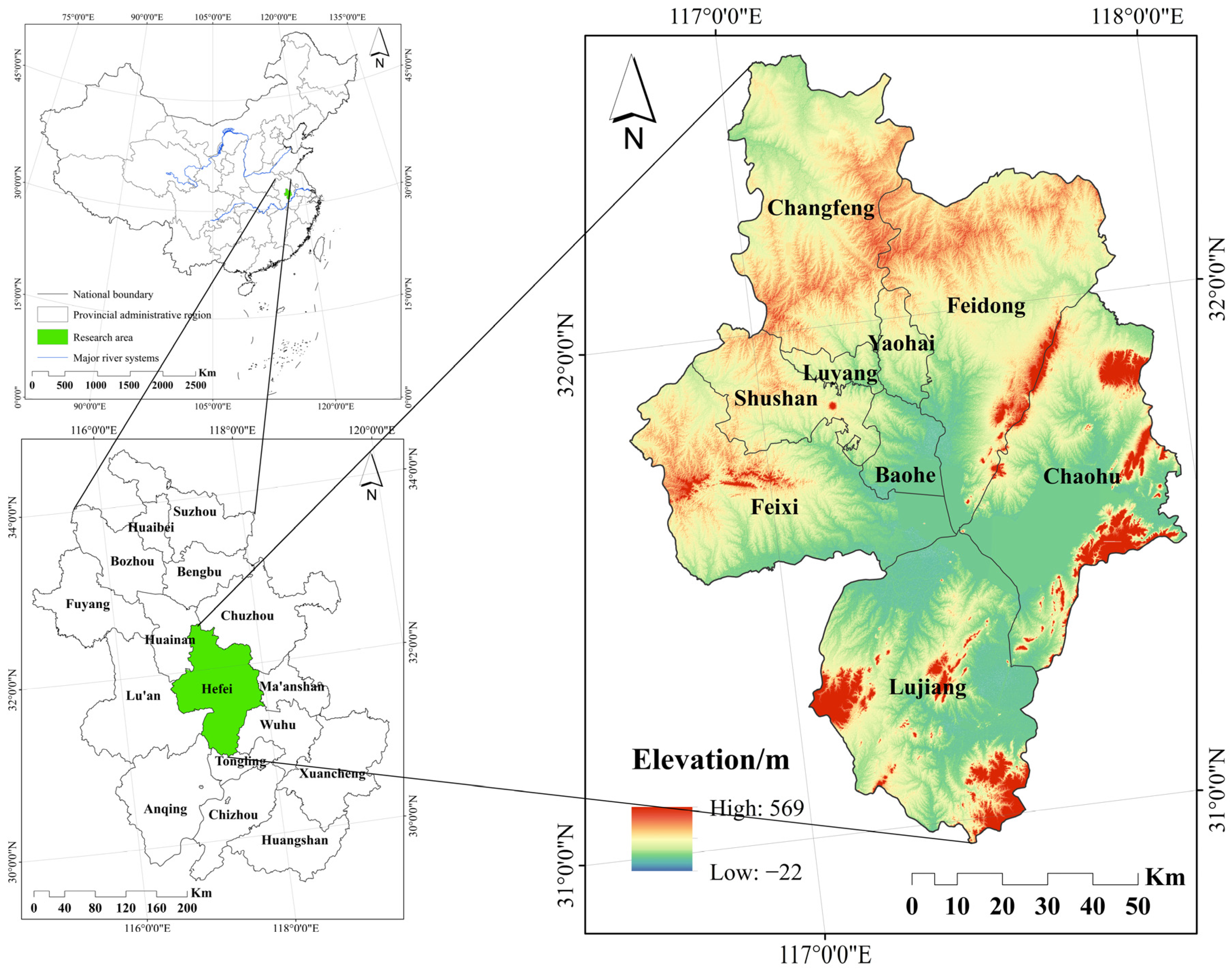

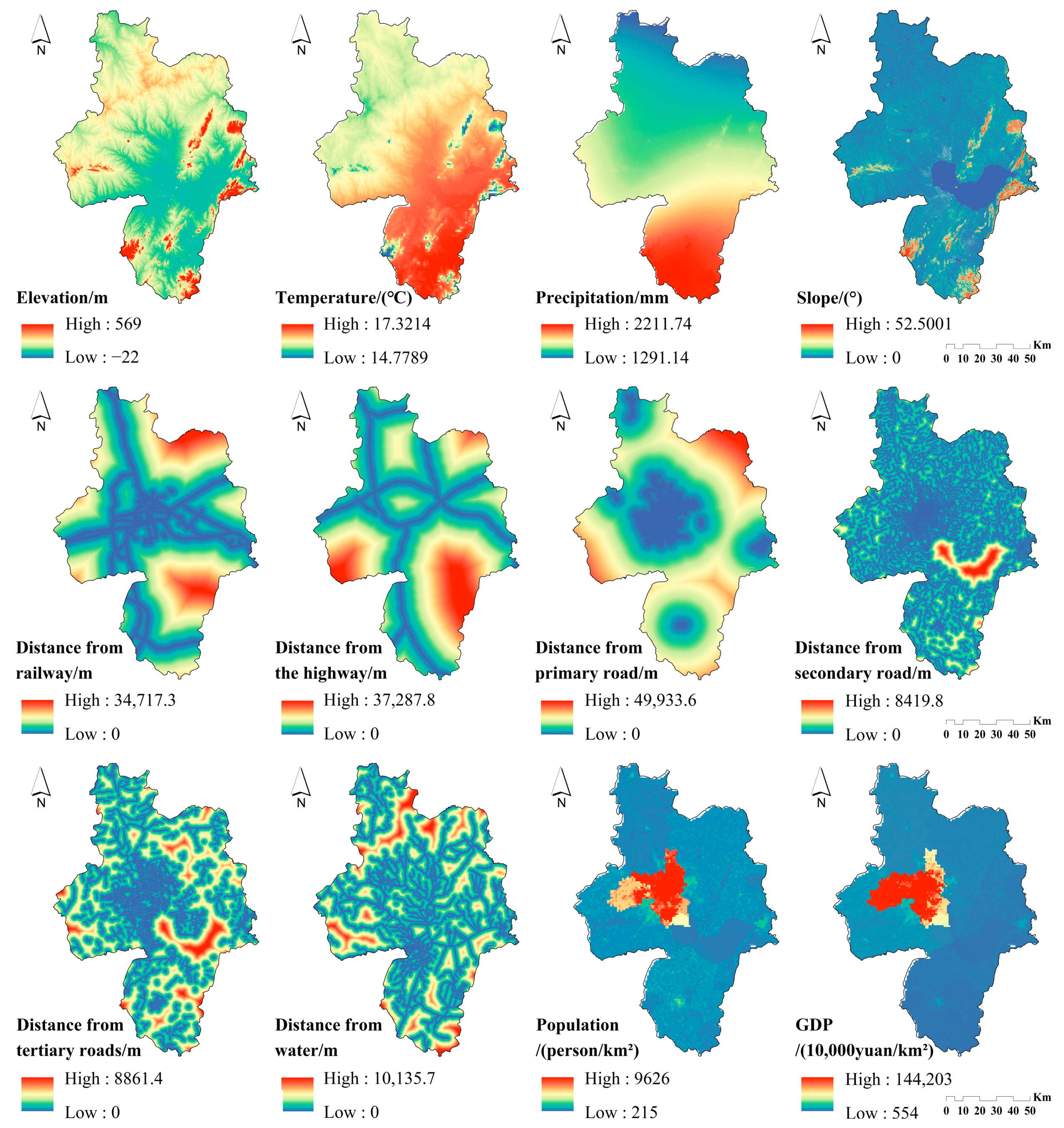
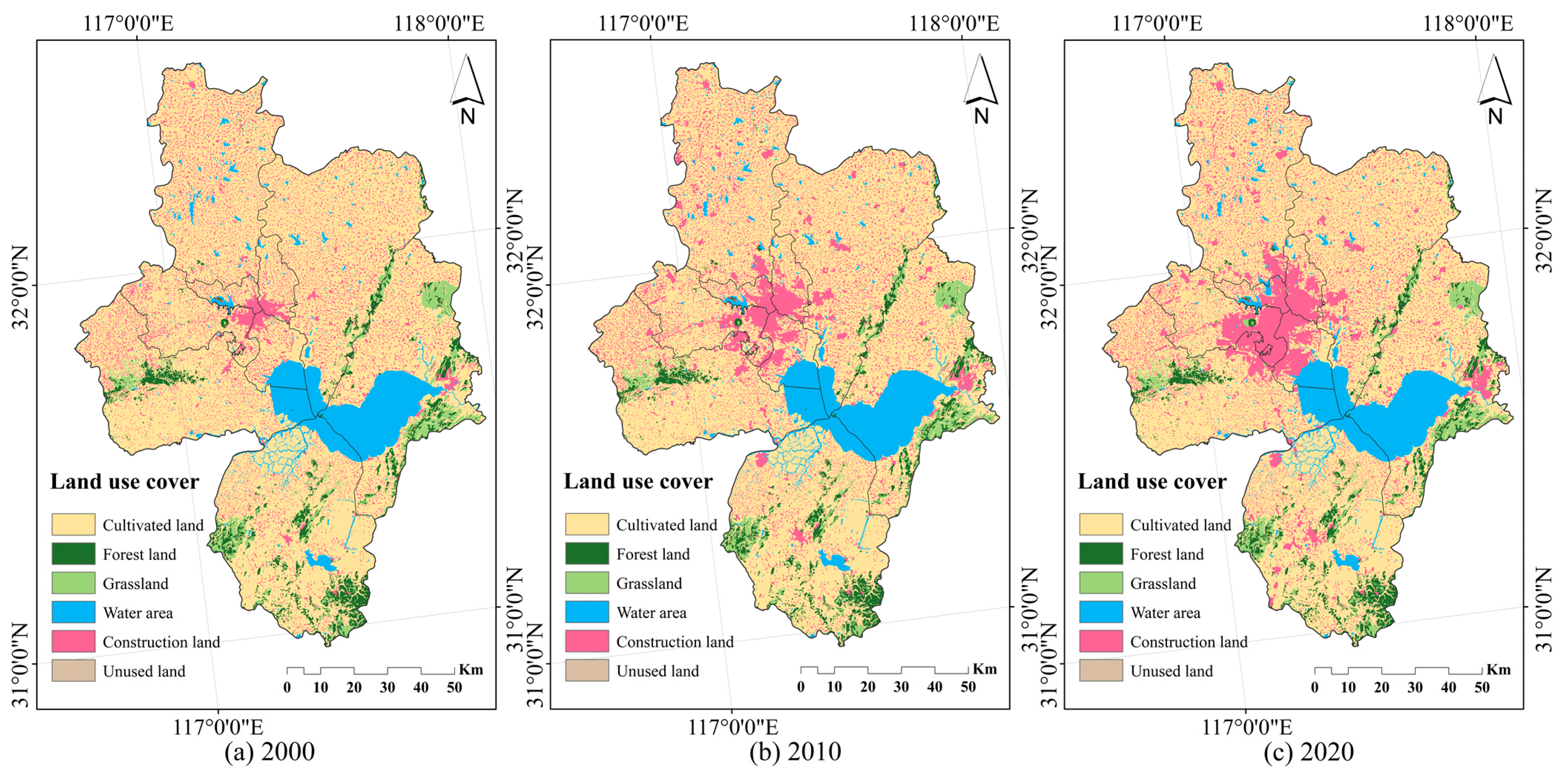

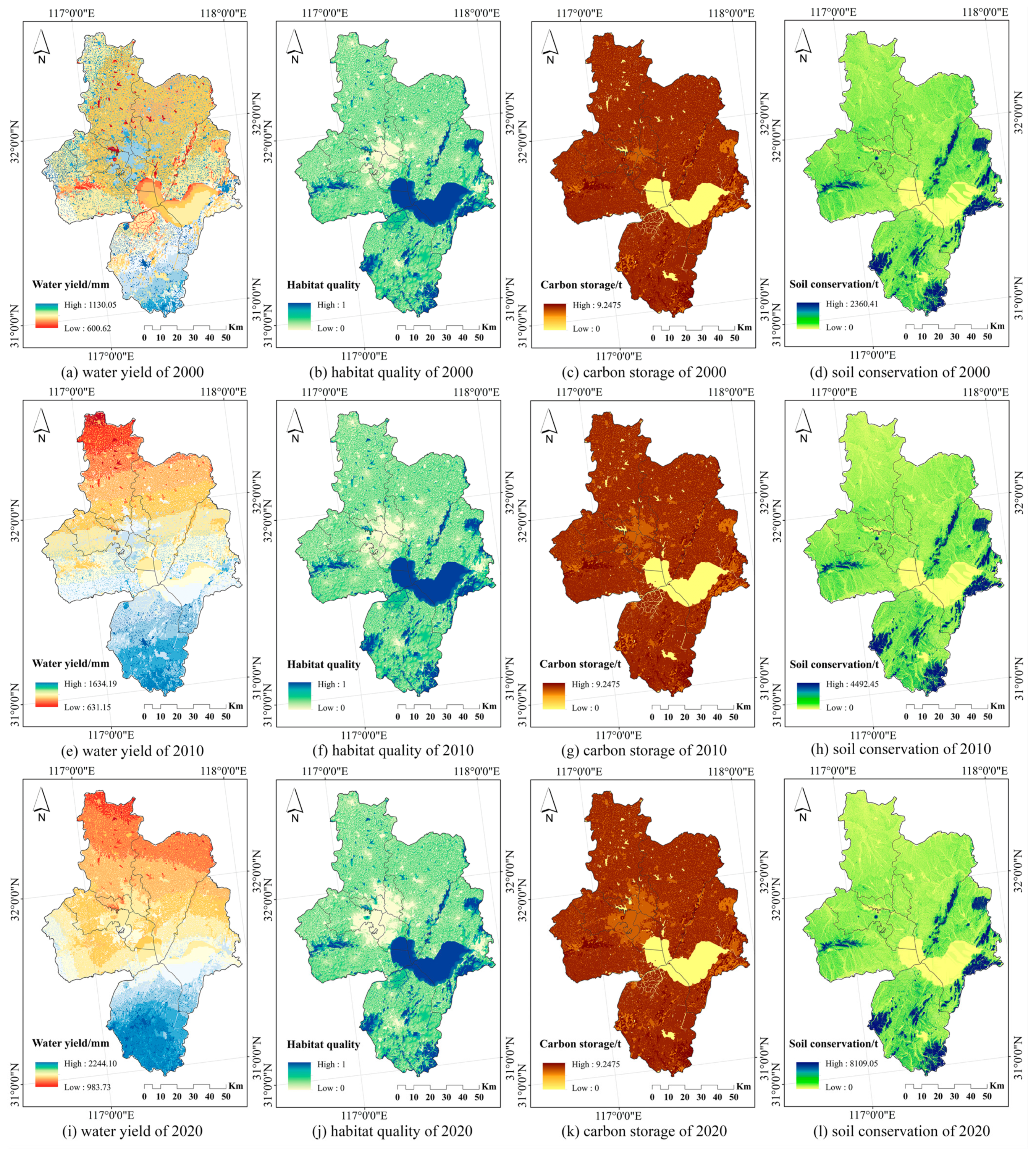

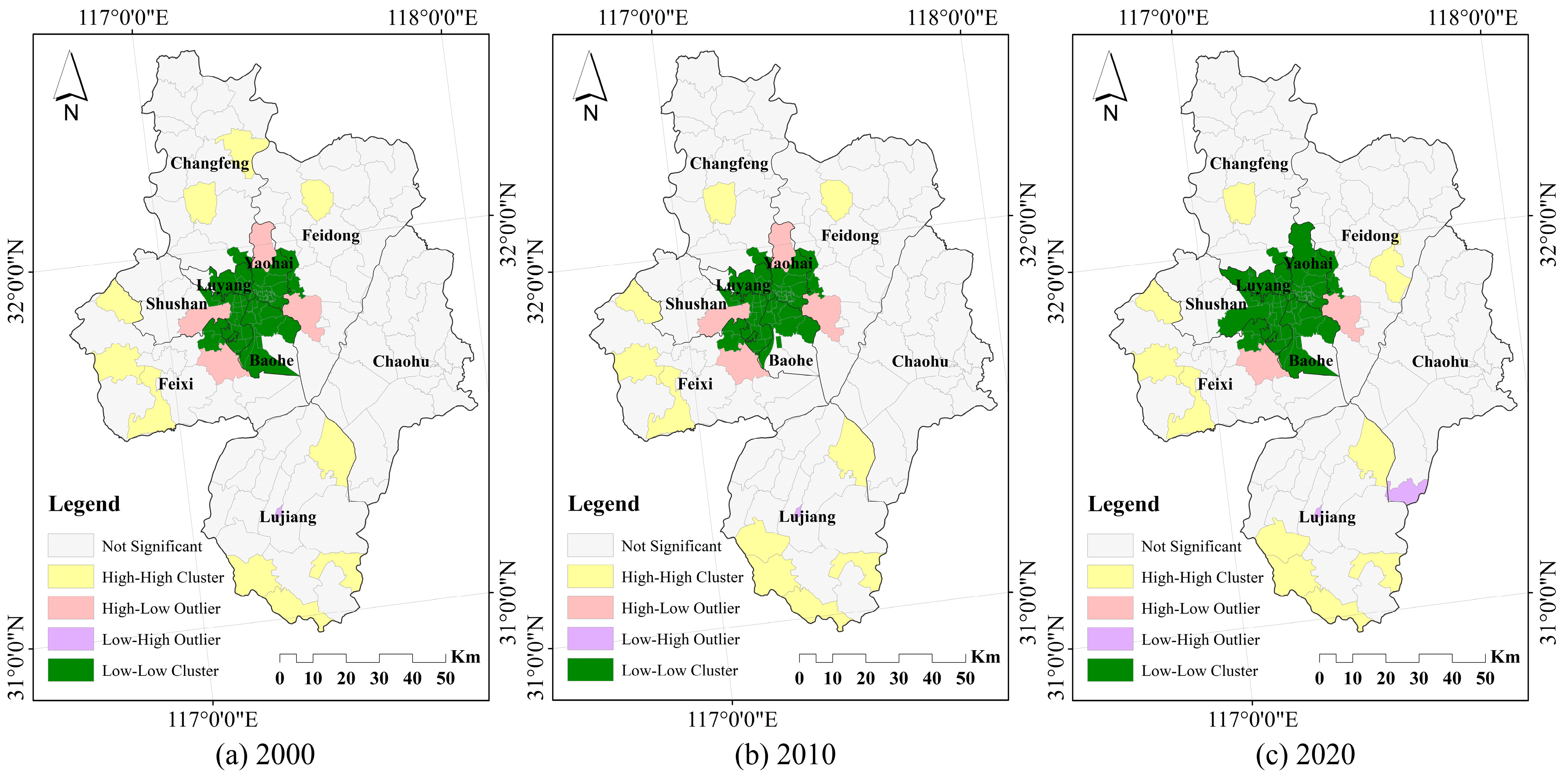

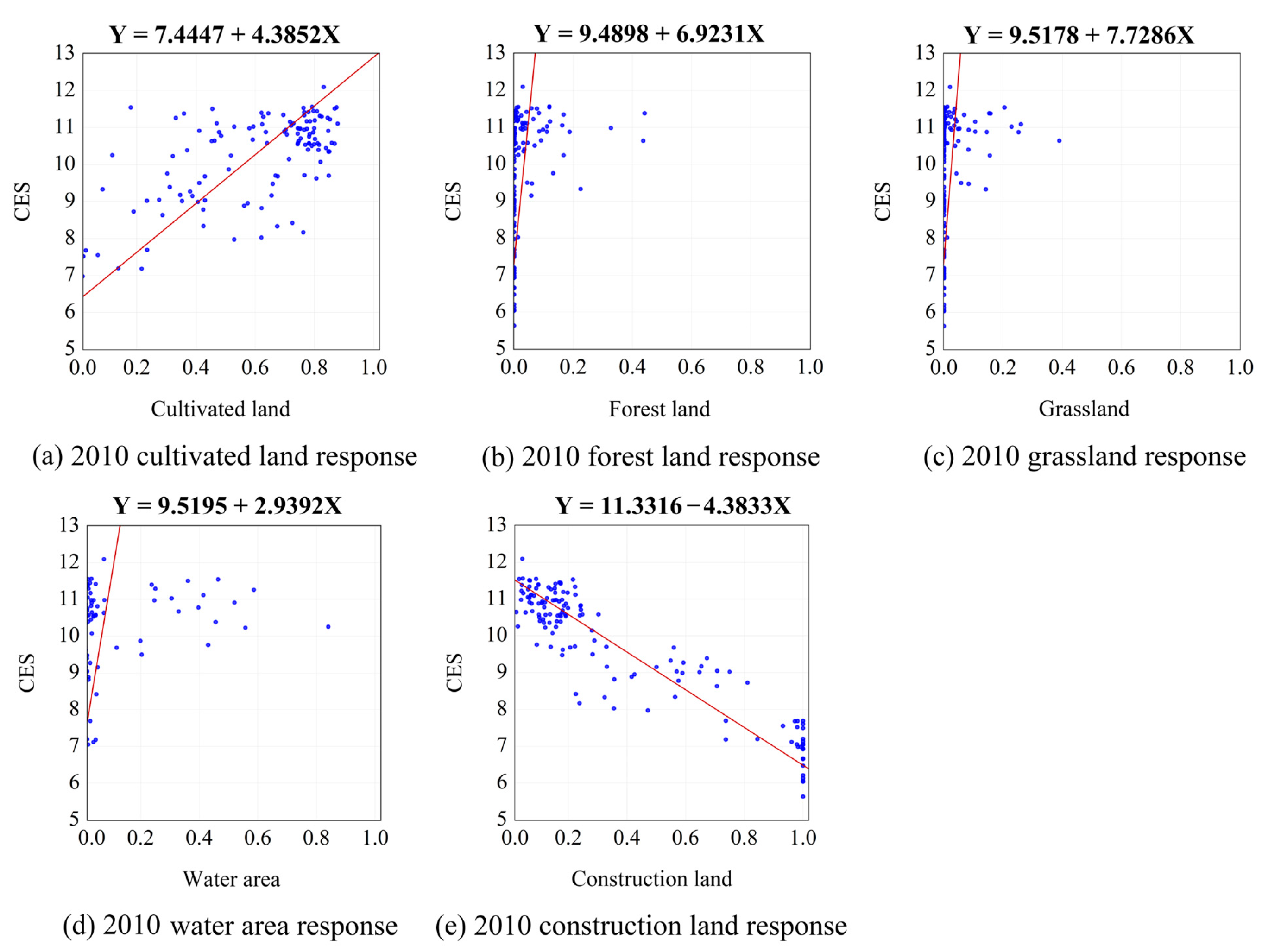
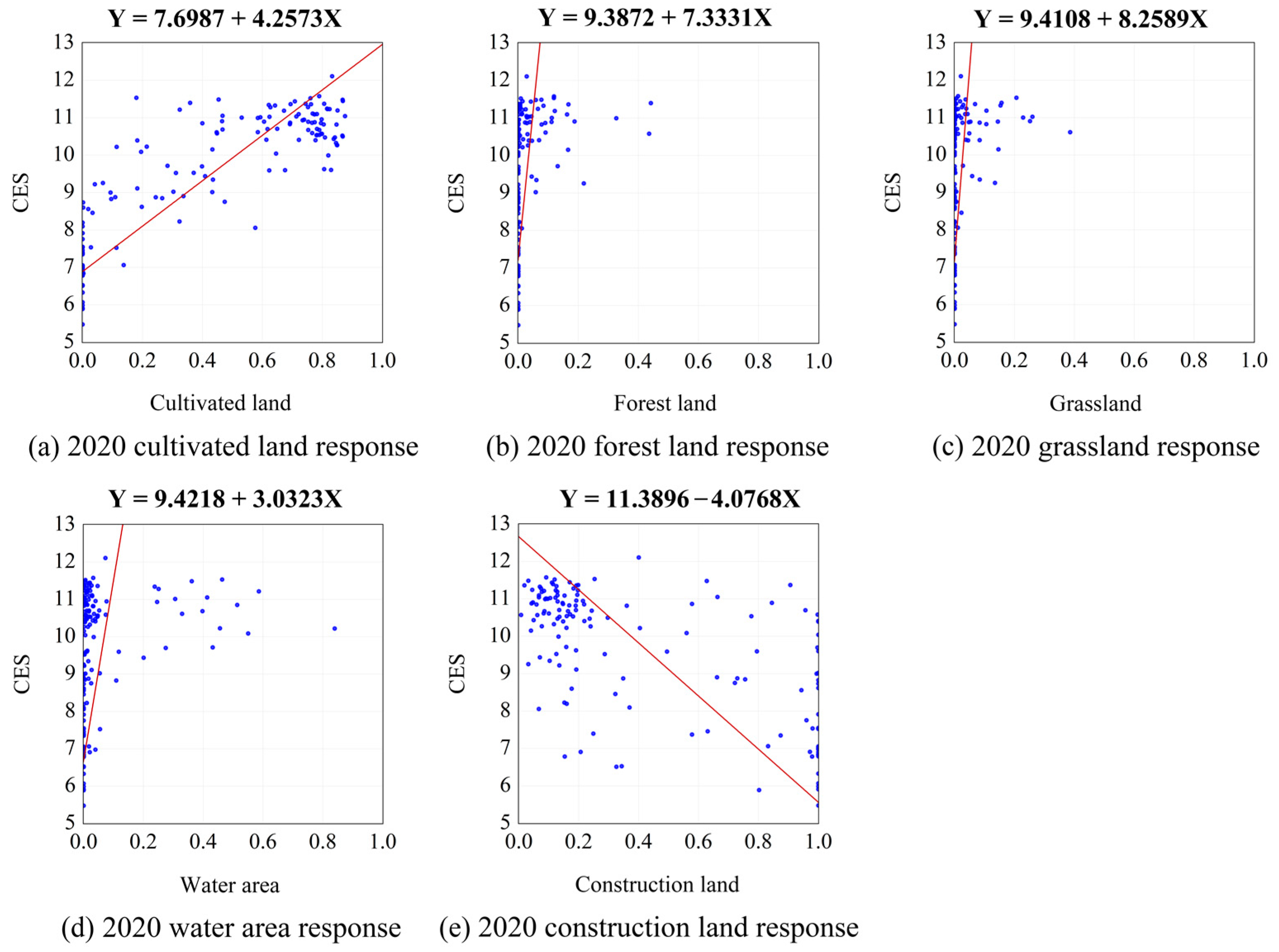
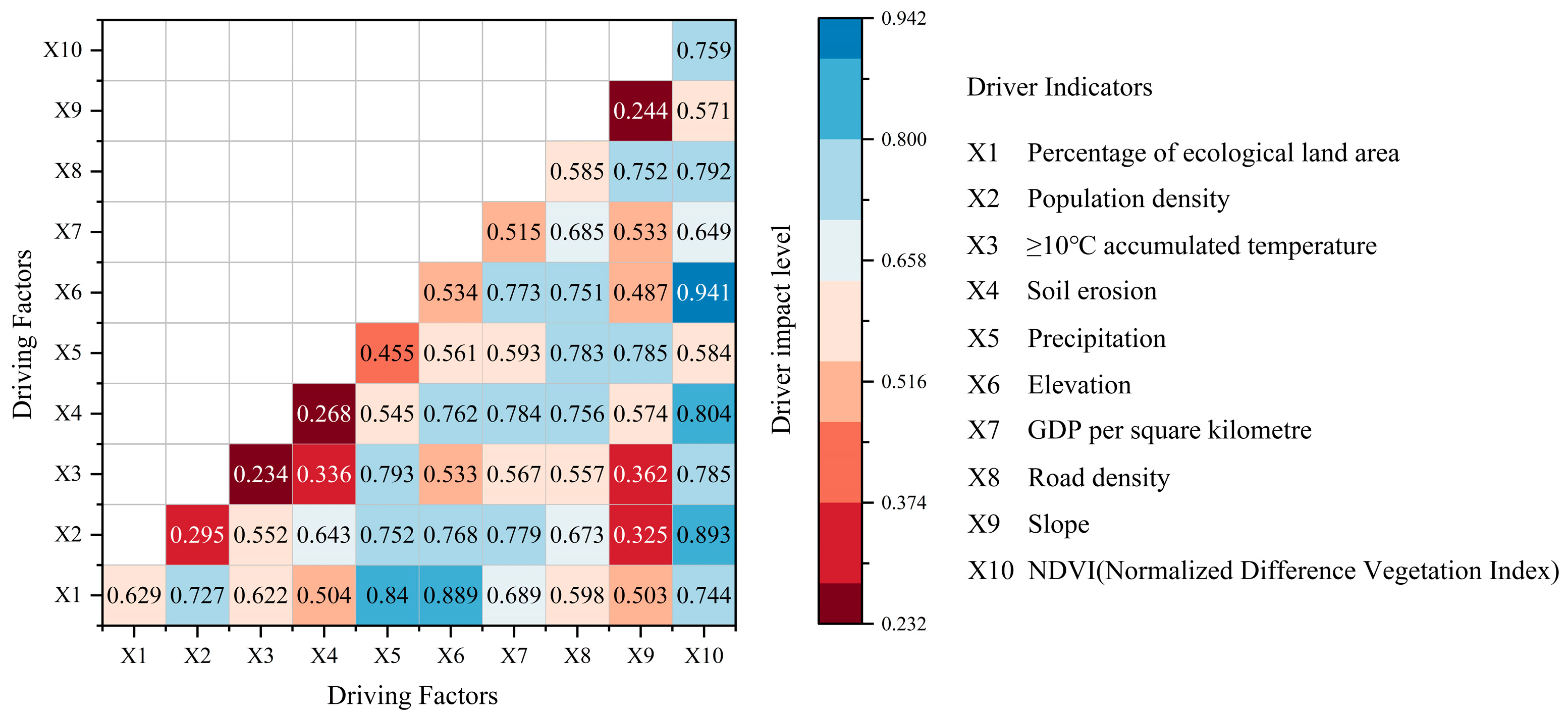
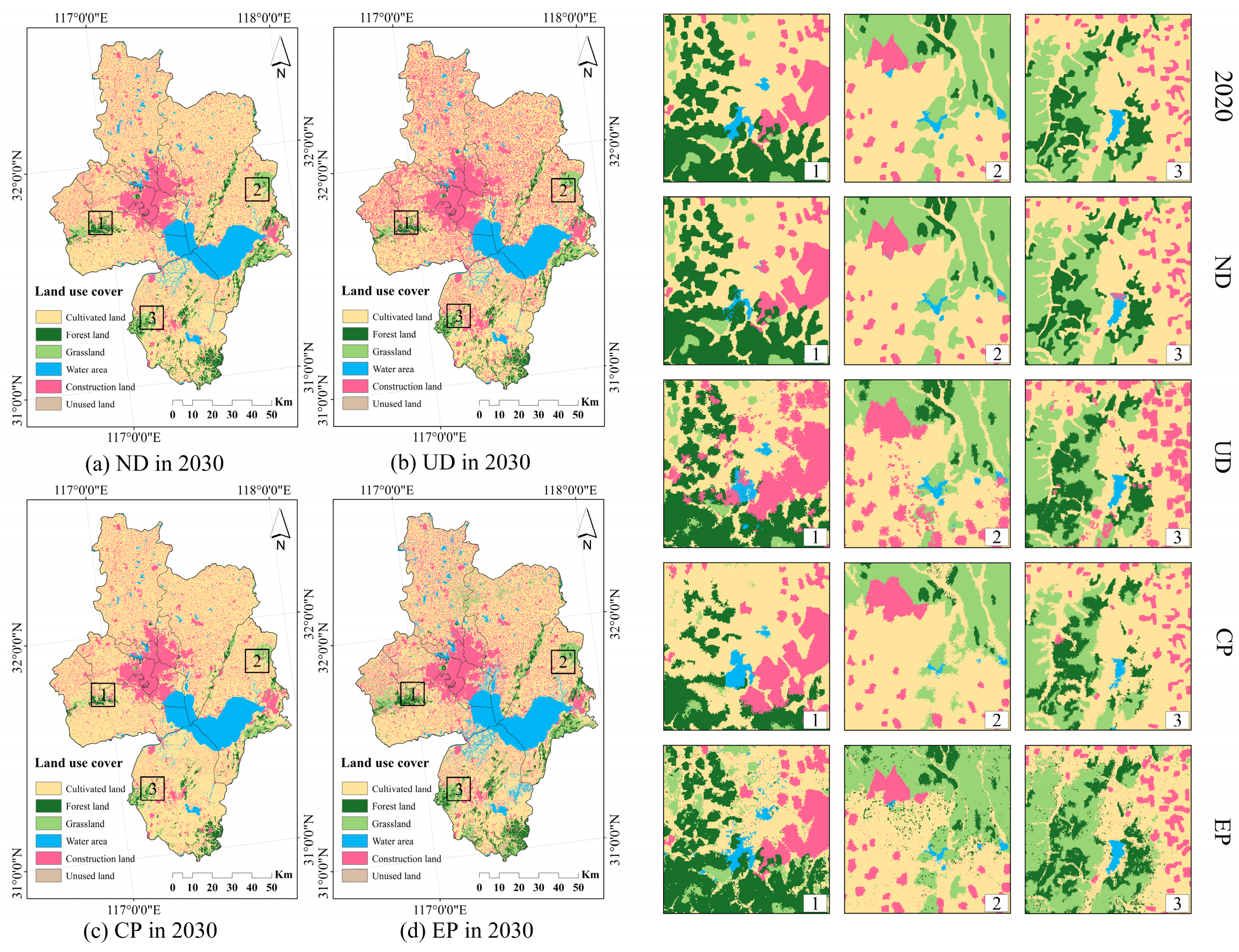
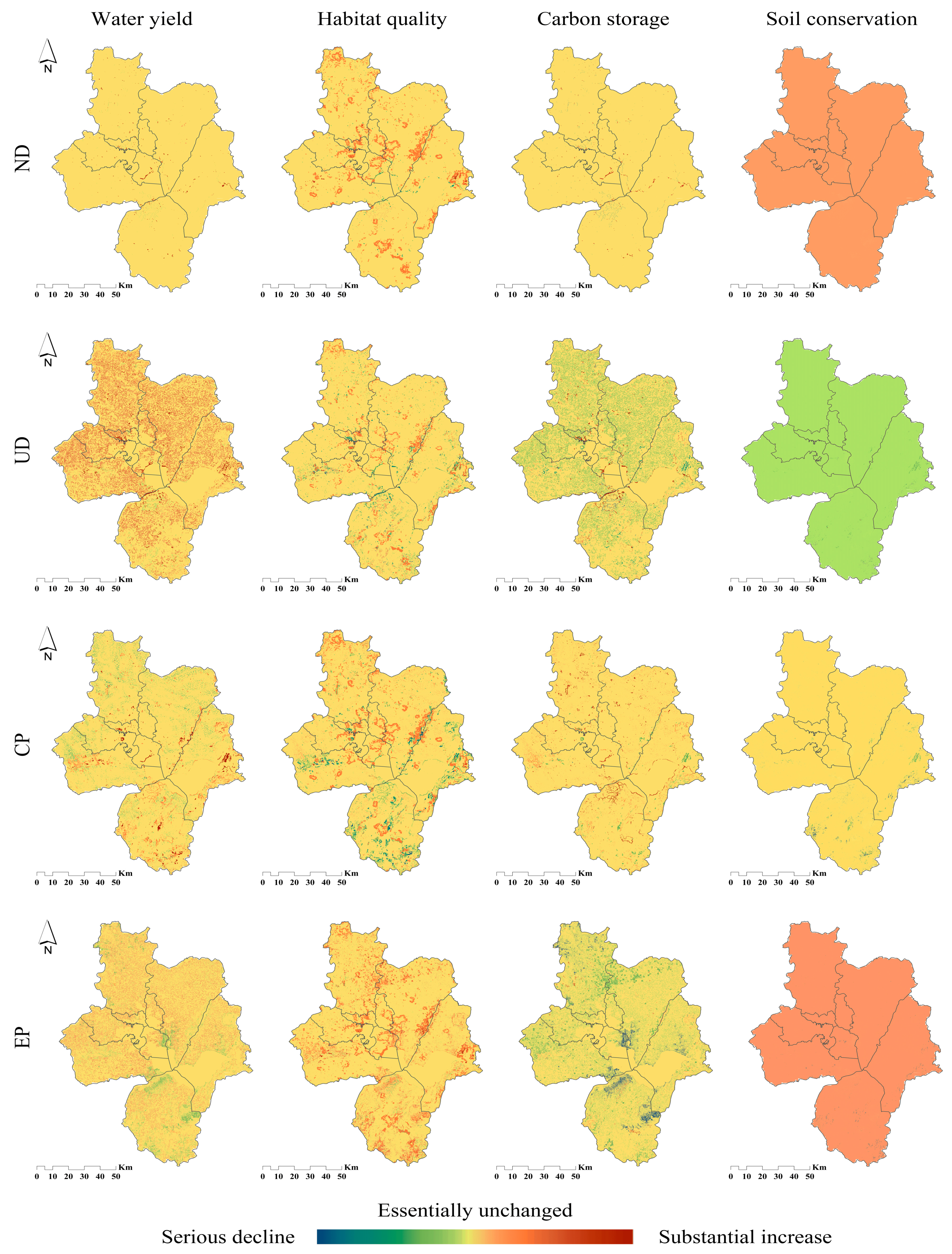

| Data Name | Year | Resolution/m | Data Sources | Model | Study Resources |
|---|---|---|---|---|---|
| Annual precipitation | 2000, 2010, 2020 | 1 | http://www.geodata.cn, accessed on 16 August 2023. | InVEST | Li, M. (2021) [23] Ren, Y. (2023) [24] |
| Evapotranspiration | 2000, 2010, 2020 | 1 | http://www.geodata.cn, accessed on 16 August 2023 | InVEST | |
| Rainfall erosivity | 2000, 2010, 2020 | 30 | https://www.geodata.cn, accessed on 16 August 2023. | InVEST | |
| Soil erodibility | 2000, 2010, 2020 | 30 | https://www.geodata.cn, accessed on 18 August 2023. | InVEST | |
| DEM | 2000, 2010, 2020 | 30 | http://www.gscloud.cn, accessed on 16 August 2023. | InVEST | |
| Temperature | 2000, 2010, 2020 | 1000 | http://www.resdc.cn, accessed on 19 August 2023 | InVEST | |
| GDP | 2000, 2010, 2020 | 1000 | http://www.resdc.cn, accessed on 20 November 2023. | PLUS | Liang, X. (2021) [20] |
| Land use | 2000, 2010, 2020 | 10 | http://www.resdc.cn, accessed on 23 July 2023. | PLUS | |
| Population density | 2000, 2010, 2020 | 1000 | http://www.resdc.cn, accessed on 30 September 2023. | Geographical detector | Huang, M. (2019) [25] |
| Scenarios | Scenario Notes |
|---|---|
| Natural Development (ND) | It is the extent of land utilization remains constant between the years 2000 and 2020. |
| Urban Development (UD) | It strictly forbids the transformation of property designated for construction land purposes into other types of land while adhering to the policy guidelines aimed at minimizing the unregulated growth of construction land. |
| Cultivated land Protection (CP) | It simulates the impacts of implementing the cultivated land protection policy, which prohibits the conversion of cultivated land to other land uses and ensures the preservation of essential farmed land. |
| Ecological Protection (EP) | It places a high priority on the protection of forest land and other ecological land. The objective is to reduce the transformation of forest land into other land uses while promoting the conversion of non-forested land into forested areas. |
| Cultivated Land | Forest Land | Grassland | Water Area | Construction Land | Unused Land | |
|---|---|---|---|---|---|---|
| ND | 0.5 | 0.7 | 0.3 | 0.4 | 1 | 0.01 |
| UD | 0.4 | 0.5 | 0.2 | 0.4 | 1 | 0.01 |
| CP | 0.8 | 0.5 | 0.3 | 0.2 | 0.8 | 0.01 |
| EP | 0.3 | 1 | 0.7 | 0.8 | 0.8 | 0.01 |
| Impact Layer | Influence Layer Weight | Indicator Layer | Indicator Layer Weights | Final Weights |
|---|---|---|---|---|
| Regulation Services | 0.53 | Carbon storage | 0.59 | 0.31 |
| Soil conservation | 0.41 | 0.22 | ||
| Supply Services | 0.25 | Water yield | 1 | 0.25 |
| Support Services | 0.22 | Habitat quality | 1 | 0.22 |
| Scenarios | Changes in Values of Ecological Indicators | Rate of Change of Ecological Indicators | ||||||
|---|---|---|---|---|---|---|---|---|
| Water Yield | Habitat Quality | Carbon Storage | Soil Conservation | Water Yield | Habitat Quality | Carbon Storage | Soil Conservation | |
| ND | 1478.05 | 0.40 | 7.22 | 12.57 | 0.66% | −5.87% | 0.36% | −0.06% |
| UD | 1492.61 | 0.35 | 7.08 | 12.65 | 1.65% | −18.89% | −1.64% | 0.53% |
| CP | 1480.71 | 0.38 | 7.29 | 12.60 | 0.84% | −12.28% | 1.28% | 0.12% |
| EP | 1477.64 | 0.44 | 6.95 | 12.60 | −0.93% | 2.70% | 0.88% | 0.46% |
| Types of Land | Serious Decline | Moderate Decline | Mild Decline | Essentially Unchanged | Mild Increase | Moderate Increase | Substantial Increase | |
|---|---|---|---|---|---|---|---|---|
| ND | Cultivated land | 0.07% | 0.04% | 83.28% | 16.60% | 0.01% | 0.00% | 0.00% |
| Forest land | 0.02% | 0.06% | 54.78% | 28.91% | 16.23% | 0.00% | 0.00% | |
| Grassland | 0.00% | 0.09% | 63.65% | 34.65% | 1.61% | 0.00% | 0.00% | |
| Water area | 0.09% | 15.17% | 71.99% | 7.59% | 2.65% | 2.22% | 0.28% | |
| Construction land | 0.00% | 0.00% | 99.88% | 0.11% | 0.01% | 0.00% | 0.00% | |
| Unused land | 0.00% | 0.00% | 99.50% | 0.50% | 0.00% | 0.00% | 0.00% | |
| UD | Cultivated land | 0.19% | 15.17% | 77.01% | 7.48% | 0.05% | 0.10% | 0.00% |
| Forest land | 4.13% | 30.18% | 43.90% | 15.45% | 6.17% | 0.18% | 0.00% | |
| Grassland | 0.22% | 5.82% | 76.01% | 14.34% | 0.90% | 2.71% | 0.00% | |
| Water area | 0.08% | 12.97% | 71.23% | 4.45% | 6.26% | 4.96% | 0.04% | |
| Construction land | 0.00% | 0.79% | 99.15% | 0.05% | 0.00% | 0.00% | 0.00% | |
| Unused land | 0.01% | 0.70% | 37.66% | 0.46% | 60.22% | 0.96% | 0.00% | |
| CP | Cultivated land | 0.00% | 0.00% | 0.03% | 99.93% | 0.03% | 0.01% | 0.00% |
| Forest land | 0.08% | 4.57% | 41.46% | 53.10% | 0.78% | 0.00% | 0.00% | |
| Grassland | 0.00% | 0.03% | 2.32% | 94.40% | 3.25% | 0.00% | 0.00% | |
| Water area | 0.00% | 0.00% | 0.02% | 88.08% | 10.78% | 1.12% | 0.00% | |
| Construction land | 0.00% | 0.00% | 0.01% | 99.97% | 0.02% | 0.00% | 0.00% | |
| Unused land | 0.00% | 0.00% | 0.00% | 51.08% | 48.57% | 0.35% | 0.00% | |
| EP | Cultivated land | 0.00% | 2.61% | 0.00% | 1.61% | 95.04% | 0.74% | 0.00% |
| Forest land | 0.00% | 3.13% | 0.38% | 0.10% | 89.32% | 7.07% | 0.00% | |
| Grassland | 0.00% | 0.10% | 0.02% | 0.01% | 94.66% | 5.20% | 0.00% | |
| Water area | 0.00% | 0.07% | 0.00% | 0.13% | 98.54% | 0.91% | 0.35% | |
| Construction land | 0.00% | 1.41% | 0.05% | 2.84% | 88.74% | 6.96% | 0.00% | |
| Unused land | 0.00% | 0.33% | 0.00% | 0.35% | 96.10% | 2.59% | 0.62% |
Disclaimer/Publisher’s Note: The statements, opinions and data contained in all publications are solely those of the individual author(s) and contributor(s) and not of MDPI and/or the editor(s). MDPI and/or the editor(s) disclaim responsibility for any injury to people or property resulting from any ideas, methods, instructions or products referred to in the content. |
© 2024 by the authors. Licensee MDPI, Basel, Switzerland. This article is an open access article distributed under the terms and conditions of the Creative Commons Attribution (CC BY) license (https://creativecommons.org/licenses/by/4.0/).
Share and Cite
Yan, X.; Huang, M.; Tang, Y.; Guo, Q.; Wu, X.; Zhang, G. Study on the Dynamic Change of Land Use in Megacities and Its Impact on Ecosystem Services and Modeling Prediction. Sustainability 2024, 16, 5364. https://doi.org/10.3390/su16135364
Yan X, Huang M, Tang Y, Guo Q, Wu X, Zhang G. Study on the Dynamic Change of Land Use in Megacities and Its Impact on Ecosystem Services and Modeling Prediction. Sustainability. 2024; 16(13):5364. https://doi.org/10.3390/su16135364
Chicago/Turabian StyleYan, Xinyu, Muyi Huang, Yuru Tang, Qin Guo, Xue Wu, and Guozhao Zhang. 2024. "Study on the Dynamic Change of Land Use in Megacities and Its Impact on Ecosystem Services and Modeling Prediction" Sustainability 16, no. 13: 5364. https://doi.org/10.3390/su16135364





